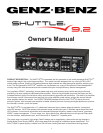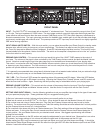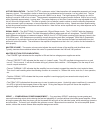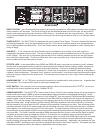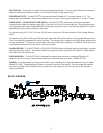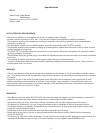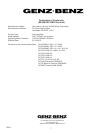
REAR PANEL
DIRECT OUTPUT – An XLR balanced direct output is provided for connection to a PA system or directly into a recording
studio console or A/D converter. The Direct Out signal may be switched between mic and line level, pre and post EQ,
and the audio signal ground may be connected or lifted from pin 1 to eliminate hum due to ground loops. This output
is fully protected against 48 volt phantom power and may be used for driving microphone lines of up to 300 feet without
problems.
TUNER OUTPUT – The SHUTTLE
®
9.2 is equipped with a fully isolated Tuner Output. This jack is located after the front
end scaling preamplier, but is pre-signal shape and pre-EQ. This output may also be used to drive a separate direct
box or high-impedance recording device. The Tuner Output remains active when the amplier is muted, allowing silent
tuning on stage.
AUX INPUT – A 1/4” unbalanced line level Auxiliary Input is provided that sums directly to the main output bus,
controlled by the master volume control. This input is ideal for practicing with recorded tracks from a CD player, iPOD,
or MP-3 player. This input is a tip-ring-sleeve type jack with built-in summing resistors that sum left and right signals
when used with a stereo cable. This input will also work with a mono tip-sleeve plug. Adjust the level of the playback
source to balance with the bass guitar’s volume.
EFFECTS LOOP – A rear panel effects loop (SEND and RECEIVE jacks) is provided for connecting “serial” outboard
devices such as compressors and may also be used for parallel type outboard devices (delays, reverbs, harmonizers,
octavers etc.) by using the mix control located on the outboard device. This loop is located right before the Master
Volume control and is also intended as a Preamp Out / Power Amp In connection for possible “chaining” of ampliers in
a Master / Slave conguration. The effects “loop” contains a “normal switch” in the receive jack that interrupts the signal
path when a plug is inserted into the receive jack. The send jack may be used for an aux. output without breaking the
signal path.
HEADPHONE OUT – A 1/4” TRS jack is provided for connection to headphones for silent practice use. A speaker load
is not required. Do not connect this output to anything but headphones.
FOOT SWITCH – This connector is for connecting the optional 4 button foot switch to the SHUTTLE
®
9.2. Do not use
anything but the factory supplied foot switch. Model# F/S-STL.
POWER AMPLIFIER – The SHUTTLE
®
9.2 uses a state of the art, Class D power amplier design and a high frequency
switch-mode power supply (SMPS) to achieve unprecedented high performance and lightweight packaging. Switch-
mode power supplies convert the AC line directly to high voltage DC, then the precision PWM (pulse width modulation)
inverter creates a new AC power signal at a frequency more than 1000 times higher than the original wall frequency of
50/60Hz. This new high voltage, high frequency power signal is then fed into a custom high frequency transformer that
steps the voltage down. A high frequency rectier and high ESR lter capacitors nish the process off by converting
the high frequency AC signal back to the DC voltages that the amplier’s internal circuitry uses. One advantage of this
conversion process is that the DC power supply rails are refreshed more than 1000 times more often than in traditional
linear supplies, thus reducing annoying hum in the audio signal. The high frequency switching is used to reduce the
size and weight of the magnetic and lter components while increasing the performance by recharging the power supply
rails more often. The Class D amplier uses digital PWM techniques similar to those in more familiar digital to analog
converters to reduce the size and weight by a factor of 10 times that of a comparably rated conventional class AB
amplier. Essentially, a Class D amplier converts the analog signal into a logic level PWM digital signal with an analog
to digital converter, level shifts this PWM signal up to a higher voltage and current and then reconstructs the analog
signal by passing it through what is essentially a power digital to analog converter. Additionally, we developed our own
proprietary 3DPM™ technology to give a distinctly analog feel and sound to the Class D platform. This system provides
exceptional performance even for low frequency applications such as bass guitar.
4



